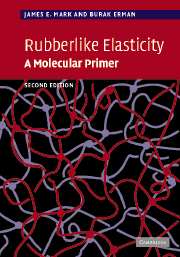Book contents
- Frontmatter
- Contents
- Preface to the first edition
- Preface to the second edition
- Part I Fundamentals
- Part II Additional topics
- 11 Networks prepared under unusual conditions
- 12 Strain-induced crystallization and ultimate properties
- 13 Multimodal networks
- 14 Birefringence and segmental orientation
- 15 Neutron scattering from networks
- 16 Liquid-crystalline elastomers
- 17 Bioelastomers
- 18 Filled elastomers
- 19 Current problems and new directions
- Appendix A Relationships between ν, ξ and Mc
- Appendix B Relationships between 〈r2〉, 〈(Δr)2〉, 〈r2〉0, and ϕ
- Appendix C Equations of state for miscellaneous deformations from the constrained junction theory
- Appendix D Thermodynamics of the relationship of stress to temperature
- Problems
- Answers to problems
- Some publications describing laboratory/classroom experiments or demonstrations
- References
- Index
17 - Bioelastomers
from Part II - Additional topics
Published online by Cambridge University Press: 04 December 2009
- Frontmatter
- Contents
- Preface to the first edition
- Preface to the second edition
- Part I Fundamentals
- Part II Additional topics
- 11 Networks prepared under unusual conditions
- 12 Strain-induced crystallization and ultimate properties
- 13 Multimodal networks
- 14 Birefringence and segmental orientation
- 15 Neutron scattering from networks
- 16 Liquid-crystalline elastomers
- 17 Bioelastomers
- 18 Filled elastomers
- 19 Current problems and new directions
- Appendix A Relationships between ν, ξ and Mc
- Appendix B Relationships between 〈r2〉, 〈(Δr)2〉, 〈r2〉0, and ϕ
- Appendix C Equations of state for miscellaneous deformations from the constrained junction theory
- Appendix D Thermodynamics of the relationship of stress to temperature
- Problems
- Answers to problems
- Some publications describing laboratory/classroom experiments or demonstrations
- References
- Index
Summary
Introduction
Bioelastomers, or elastomeric biopolymers, are utilized by living organisms in a variety of tissues for a number of purposes. In vertebrates, including mammals such as humans, examples of tissues are the skin, arteries and veins, and organs such as the lungs and heart. As is obvious, all these tissues involve the already-mentioned characteristics of deformability with recoverability.
There are two general reasons for studying the elasticity of such materials. The more fundamental one is the simple desire to understand rubberlike elasticity in as broad a context as possible. The more practical one is to learn how nature designs and produces these materials, so as possibly to obtain some guidance on the commercial preparation of more useful non-biopolymeric elastomers.
The bioelastomers that have been investigated with regard to their rubberlike elasticity are listed in Table 17.1. All are proteins and thus have the repeat unit shown in Figure 17.1, where the side group R is different for the different α-amino acids that produce this chain structure. Although there are a variety of bioelastomers, elastin has been the most studied by far. It is thus emphasized in following sections.
Structural choices
Elastin is, of course, a chemical copolymer, and its repeat unit sequence is sufficiently irregular that it is always totally amorphous. This use of copolymerization to suppress the large amounts of crystallinity that would interfere with elastomeric behavior is also practiced by synthetic polymer chemists.
- Type
- Chapter
- Information
- Rubberlike ElasticityA Molecular Primer, pp. 179 - 190Publisher: Cambridge University PressPrint publication year: 2007



